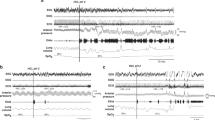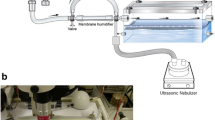Abstract
The effects of upper airway (UA) cool air and CO2 on breathing and on laryngeal and supraglottic resistances were studied in anaesthetised rats breathing spontaneously through a tracheostomy. Warm, humidified air containing 0, 5 and 9–10% CO2 and cool, room-humidity air were delivered at constant flow to either the isolated larynx to exit through a pharyngotomy or to the supraglottic UA to exit through the mouth and/or nose (nose open or sealed). Spontaneous tracheal airflow and UA airflows, temperatures and pressures were recorded. CO2 had no effect on breathing but caused a slight increase in laryngeal resistance which was abolished by cutting the superior laryngeal nerves (SLN). Cool air caused a decrease in respiratory frequency and/or peak inspiratory flow when applied to the isolated larynx or to the supraglottic airway with the nose closed. These effects were abolished by SLN section. With the nose open, the ventilatory inhibition was not abolished by SLN section. Cool air also caused substantial decreases in laryngeal and supraglottic resistances which were attenuated by SLN section and which persisted following recurrent laryngeal nerve section. In conclusion, whilst UA cooling inhibits breathing and decreases UA resistances, UA CO2 has minimal effects.
Similar content being viewed by others
References
Anderson JW, Sant'Ambrogio FW, Orani GP, Sant'Ambrogio G (1990) Carbon dioxide-responsive laryngeal receptors in the dog. Respir Physiol 82:217–226
Bartlett D Jr, Knuth SL (1992) Responses of laryngeal receptors to intralaryngeal CO2 in the cat. J Physiol (Lond) 457:187–193
Bartlett D Jr, Knuth SL, Gdovin MJ (1992) Influence of laryngeal CO2 on respiratory activities of motor nerves to accessory muscles. Respir Physiol 90:289–297
Bartlett D Jr, Knuth SL, Leiter JC (1992) Alteration of ventilatory activity by intralaryngeal CO2 in the cat. J Physiol (Lond) 457:177–185
Basner RC, Ringler J, Berkowitz S, Schwartzstein RM, Weinberger SE, Sparrow D, Woodrow Weiss J (1990) Effect of inspired air temperature on genioglossus activity during nose breathing in awake humans. J Appl Physiol 69:1098–1103
Bigland-Ritchie B, Thomas CK, Rice CL, Howarth JV, Woods JJ (1992) Muscle temperature, contractile speed and motoneuron firing rates during human voluntary contractions. J Appl Physiol 73:2457–2461
Boushey HA, Richardson PS (1973) The reflex effects of intralaryngeal carbon dioxide on the pattern of breathing. J Physiol (Lond) 228:181–191
Boushey HA, Richardson PS, Widdicombe JG, Wise JCM (1974) The response of laryngeal afferent fibres to mechanical and chemical stimuli. J Physiol (Lond) 240:153–175
Bradford A, Nolan P, McKeogh D, Bannon C, O'Regan RG (1990) The responses of superior laryngeal nerve afferent fibres to laryngeal airway CO2 concentration in the anaesthetised cat. Exp Physiol 75:267–270
Bradford A, Nolan P, O'Regan RG, McKeogh D (1993) Carbon dioxide-sensitive superior laryngeal nerve afferents in the anaesthetised cat. Exp Physiol 78:787–798
Burgess KR, Whitelaw WA (1988) Effects of nasal cold receptors on pattern of breathing. J Appl Physiol 64:371–376
Chanaud CM, Ludlow CI (1992) Single motor unit activity of human intrinsic laryngeal muscles during respiration. Ann Otol Rhinol Laryngol 101:832–840
Jammes Y, Barthelemy P, Delpierre S (1983) Respiratory effects of cold air breathing in anaesthetised cats. Respir Physiol 54:41–54
Lee L-Y, Morton RF, McIntosh MJ, Turbek JA (1986) An isolated upper airway preparation in conscious dogs. J Appl Physiol 60:2123–2127
Mathew OP, Anderson JW, Orani GP, Sant'Ambrogio FB, Sant'Ambrogio G (1990) Cooling mediates the ventilatory depression associated with airflow through the larynx. Respir Physiol 82:359–368
Miki H, Hida W, Shindoh C, Kikuchi Y, Chonan T, Taguchi O, Inoue H, Takishima T (1989) Effects of electrical stimulation of the genioglossus on upper airway resistance in anaesthetised dogs. Am Rev Respir Dis 140:1279–1284
Mortola JP, Fisher JT (1981) Mouth and nose resistance in newborn kittens and puppies. J Appl Physiol 51:641–645
Mortola JP, Citterio G, Agostoni E (1985) Sulphur dioxide block of laryngeal receptors in rabbits. Respir Physiol 62:195–202
Nolan P, Bradford A, O'Regan RG, McKeogh D (1990) The effects of changes in laryngeal airway CO2 concentration on genioglossus muscle activity in the anaesthetised cat. Exp Physiol 75:271–274
Orani GP, Anderson JW, Sant'Ambrogio G, Sant'Ambrogio FB (1991) Upper airway cooling and 1-menthol reduce ventilation in the guinea pig. J Appl Physiol 70:2080–2086
Sant'Ambrogio G, Mathew OP, Sant'Ambrogio FB, Fisher JT (1985) Laryngeal cold receptors. Respir Physiol 59:35–44
Sant'Ambrogio G, Brambilla-Sant'Ambrogio F, Mathew OP (1986) Effect of cold air on laryngeal mechanoreceptors in the dog. Respir Physiol 64:45–56
Sant'Ambrogio FB, Mathew OP, Tsubone H, Sant'Ambrogio G (1991) Afferent activity in the external branch of the superior laryngeal and recurrent laryngeal nerves. Ann Otol Rhinol Laryngol 100:944–950
Sekizawa S, Tsubone H (1991) The respiratory activity of the superior laryngeal nerve in the rat. Respir Physiol 86:355–368
Tsubone H (1989) Nasal “flow” receptors of the rat. Respir Physiol 75:51–64
Ukabam CV, Knuth SL, Bartlett D Jr (1992) Phrenic and hypoglossal neural responses to cold airflow in the upper airway. Respir Physiol 87:157–164
Wasicko MJ, Hutt DA, Parisi RA, Neubauer JA, Mesrich R, Edelman NH (1990) The role of vascular tone in the control of upper airway collapsibility. Am Rev Respir Dis 141:1569–1577
Wasiko MJ, Leiter JC, Erlichman JS, Strobel RJ, Bartlett D Jr (1991) Nasal and pharyngeal resistance after topical mucosal vasoconstriction in normal humans. Am Rev Respir Dis 144:1048–1052
Wiles CM, Edwards RHT (1982) The effect of temperature, ischaemia and contractile activity on the relaxation rate of human muscle. Clin Physiol 2:485–497
Author information
Authors and Affiliations
Rights and permissions
About this article
Cite this article
O'Halloran, K.D., Curran, A.K. & Bradford, A. Ventilatory and upper-airway resistance responses to upper-airway cooling and CO2 in anaesthetised rats. Pflugers Arch. 429, 262–266 (1994). https://doi.org/10.1007/BF00374321
Received:
Revised:
Accepted:
Issue Date:
DOI: https://doi.org/10.1007/BF00374321




